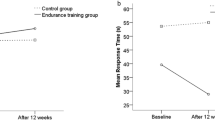Summary
The response of various thyroid hormone parameters to maximal physical exercise (MPE) was investigated in 14 medium and long distance runners and 13 divers. The effect of submaximal long time physical exercise (SMPE) was examined in seven divers. The TSH-level decreases significantly during MPE and slightly rises again after the end of the exercise. In SMPE, however, TSH continuously rises until 15 min after the end of the exercise. The T3 level rises significantly in MPE and falls below the initial value 15 min after the exercise finishes, during SMPE it remains practically unchanged and slightly decreases after the finish. In MPE, the rT3 level does not change and slightly decreases after termination, while the fT4 level continuously decreases from the beginning till 15 min after the exercise period. The latter two parameters do not show any change in SMPE. As possible reasons for the changes of TSH levels a decrease (MPE) or an increase (SMPE) of pituitary secretion might play a role. Furthermore, in MPE the rise in T3 level might be related to hemoconcentration, and the decrease in fT4 level to an elevated cellular utilization.
Similar content being viewed by others
References
Aakvaag A, Sand T, Opstad PK, Fonnum F (1978) Hormonal changes in serum in young men during prolonged physical strain. Eur J Appl Physiol 39: 283–291
Alford FP, Baker HWG, Patel YC, Rennie GC, Youatt G, Burger HG, Hudson B (1973) Temporal pattern of circulating hormones as assessed by continuous blood sampling. J Clin Endocrinol Metab 36: 108–116
Bürgi H, Labhart A (1978) Die Schilddrüse, Biochemie und Physiologie. In: Labhart A (Hrsg) Klinik der inneren Sekretion. Springer, Berlin Heidelberg New York, S 139–155
Caralis DG, Edwards L, Davis PJ (1977) Serum total and free thyroxine and triiodothyronine during dynamic muscular exercise in man. Am J Physiol 233: E115–118
De Nayer PH, Malvaux P, Ostyn M, Van Den Schrieck HG, Beckers C, De Visscher M (1968) Serum free thyroxine and binding-proteins after muscular exercise. J Clin Endocrinol Metab 28: 714–716
Eggstein M, Kreutz FH (1966) Eine neue Bestimmung der Neutralfette im Blutserum und Gewebe (I. Mitteilung). Klin Wochenschr 44: 262–267
Eggstein M (1966) Eine neue Bestimmung der Neutralfette im Blutserum und Gewebe (II. Mitteilung). Klin Wochenschr 44: 267–273
Falholt K, Lund B, Falholt W (1973) On easy colorimetric micromethod for routine determiation of free fatty acids in plasma. Clin Chim Acta 46: 105–111
Galbo H, Hummer L, Petersen IB, Christensen NJ, Bie N (1977) Thyroid and testicular hormone responses to graded and prolonged exercise in man. Eur J Appl Physiol 36: 101–106
Hohorst HJ (1962) l-(+)-Lactat, Bestimmung mit Lactat-Dehydrogenase und DPN. In: Bergmeyer HU (Hrsg) Methoden der enzymatischen Analyse. Verlag Chemie, Weinheim, S 266–270
Keul J, Haralambie G, Arnold T, Schumann W (1974) Heart rate and energy-yielding substrates in blood during long lasting running. Eur J Appl Physiol 32: 279–289
Kindermann W, Simon G, Keul J (1974) Dauertraining — Ermittlung der optimalen Trainingsherzfrequenz und LeistungsfÄhigkeit. Leistungssport 1: 34–39
Kindermann W. Keul J (1979) Anaerobe Energiebereitstellung im Hochleistungssport. Karl Hoffmann, Schorndorf, S 32–36
Kindermann W, Keul J, Lehmann M (1978) Ausdauerbelastungen beim Heranwachsenden — metabolische und cardiozirkulatorische VerÄnderungen. Fortschr Med 14: 659–665
Kirkeby K, Stromme SB, Refsum HE (1977) Effects of prolonged strenous exercise on lipids and thyroxine in serum. Acta Med Scand 202: 463–476
Lehmann M, Keul J, Schmid P, Kindermann W, Huber G (1980) Plasmakatecholamine, Glucose und Lactat sowie aerobe und anaerobe KapazitÄt bei Jugendlichen. Dtsch Z Sportmed 10: 287–295
Mader A, Heck H, Föhrenbach R, Hollmann W (1979) Das statische und dynamische Verhalten des Laktats und des SÄure-Basen-Status im Bereich niedriger bis maximaler Azidosen bei 400–800 m-LÄufern bei beiden Geschlechtern nach Belastungsabbruch. Dtsch Z Sportmed 7: 203–211
Melander A, Nilsson E, Sundler F (1972) Sympathetic activation of thyroid hormone secretion in mice. Endocrinology 90: 194–199
Melander A, Ranklev E, Sundler F, Westgren V (1975) Beta2-adrenergic stimulation of thyroid hormone secretion. Endocrinology 97: 332–336
O'Connel M, Robbins DC, Horton ES, Sims EAH, Danforth JRE (1979) Changes in serum concentrations of 3,3′,5′-Triiodothyronine and 3,5,3′-Triiodothyronine during prolonged moderate exercise. J Clin Endocrinol Metab 49: 242–246
Schmid P, Kindermann W, Huber G, Keul J (1979) Ergospirometrie und sportartspezifische LeistungsfÄhigkeit von EisschnellÄufern. Dtsch Z Sportmed 5: 136–144
Slein MW (1962) d-Glucose, Bestimmung mit Hexokinase und Glucose-6-phosphat-Dehydrogenase. In: Bergmeyer HU (Hrsg) Methoden der enzymatischen Analyse. Verlag Chemie, Weinheim, S 117–123
Terjung RL, Tipton CM (1971) Plasma thyroxine and thyroid-stimulating hormone levels during submaximal exercise in humans. Am J Physiol 220: 1840–1845
Author information
Authors and Affiliations
Rights and permissions
About this article
Cite this article
Schmid, P., Wolf, W., Pilger, E. et al. TSH, T3, rT3 and fT4 in maximal and submaximal physical exercise. Europ. J. Appl. Physiol. 48, 31–39 (1982). https://doi.org/10.1007/BF00421162
Accepted:
Issue Date:
DOI: https://doi.org/10.1007/BF00421162




